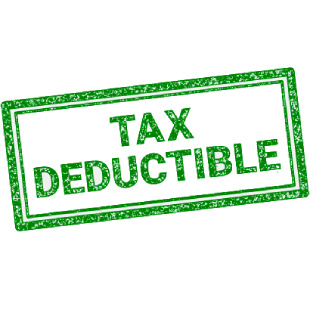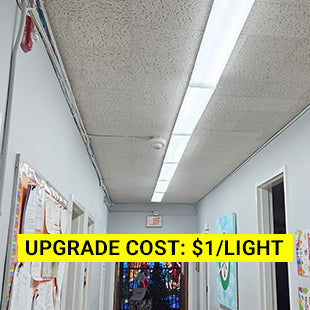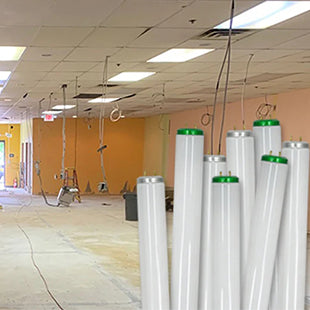Understanding the ROI of Upgrading to LED Lighting for Commercial Properties
As a property manager, you know saving money is a top priority for both building owners and tenants alike. One way to achieve this goal is by upgrading older, more costly to run lights to high-efficiency LED lighting.
LED technology has come a long way in recent years, and the benefits of making the switch are hard to ignore. Let's take a look at the return on investment (ROI) of upgrading to LED lighting in commercial properties.
The Financial Advantages of LED Lighting
LED lights and retrofits offer the following financial benefits:
- Lower energy costs: On average, lighting accounts for approximately 20-30% of a commercial building's electricity bill. LED lighting produces the same level of illumination as traditional lighting at a significantly lower energy footprint. With a building-wide upgrade, lighting costs can drop to as little as 4%-6% of the building's energy bill. By producing less heat than traditional lighting, they can also result in lower cooling costs.
- Lower maintenance costs: LED lights last, on average, 3X longer than fluorescent, metal halide, or HPS lamps, and as much as 25X times longer than incandescent or halogen lamps. This longevity is boon to your bottom line: every year that burned-out bulbs don't need to be replaced is a year without lighting maintenance expenditures.
- Eligibility for energy efficiency incentives: Many utility companies offer incentives for upgrading commercial and multi-unit residential properties to more energy-efficient systems, including lighting systems. These incentives can reduce the initial cost of the upgrade by quite a bit. For instance, with PECO Ways to Save incentives for lighting in Pennsylvania, ELEDLights customers have been able to get new, high-efficiency lighting upgrades for just $1/fixture (plus sales tax).
Calculating the ROI of LED Lighting
The ROI of upgrading to LED lighting can be calculated in a few simple steps. Online lighting calculator, like our fast & simple energy savings calculator, make it a breeze. If you have an extensive property—or properties—you can get a more comprehensive answer with help from lighting professionals, such as ELEDLights' in-house lighting pros, whose expertise is available free to our customers.
Here's a breakdown of the steps:
- Determine your current lighting costs: Start by calculating your current lighting costs. This includes the cost of electricity, maintenance, and replacement bulbs.
- Determine the cost of the LED upgrade: This includes the cost of new fixtures, installation, and any necessary upgrades to your electrical system.
-
Check for utility incentives: Does the property's utility provider have an energy efficiency incentive program? What rebates are available to offset the cost of new fixtures? Are there incentives to cover the labor costs or removal of old fixtures as well?
On our website, we're able to show instant/midstream rebates on all our rebate-eligible products; you just have to enter the installation location zip code and select the location's utility. If nothing comes up there, however, that doesn't mean there aren't any rebates available; it just means there aren't midstream rebates available. Submit a (free) rebate assistance request to have us check prescriptive rebate availability for your upgrade. - Calculate your energy savings: This is the difference between the current energy costs attributed to lighting and the (much lower) energy costs of LED replacement lights.
- Estimate your maintenance savings: How much are you currently spending in labor, scaffold or bucket truck rentals, and replacement lamp costs annually? The average operating life of LED lights is 50,000 hours; calculate how that stretches out your maintenance costs.
- Determine the payback period: Finally, determine the payback period by dividing the cost of the LED upgrade by the annual energy and maintenance savings. This will give you the number of years it will take for the LED upgrade to pay for itself.
Again, our online calculator is a big help for small jobs, and our lighting pros are available, not just to crunch numbers for larger projects but also to research energy incentives and ensure you have all the information you need to access every cent your upgrade qualifies for.
In general, we've found that LED lighting upgrades pay for themselves within 1-3 years, depending on the size and complexity of your property.
Conclusion
Upgrading to LED lighting is a smart investment for property managers, even in a tenant-paid utilities situation. LED lighting can help reduce energy and maintenance costs, and it may not even cost much to do the upgrade, thanks to incentives available from many utility companies. By calculating the ROI of an LED lighting upgrade, you can demonstrate the financial advantages of this investment to decision makers and get started benefiting from the upgrades.
Contact a lighting professional today to learn more about how LED lighting can benefit the properties you own or manage:
{formbuilder:NzEyOTM=}





